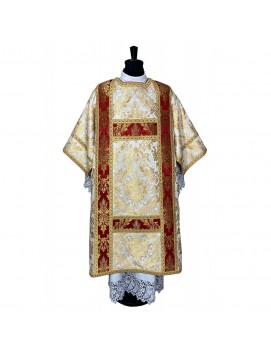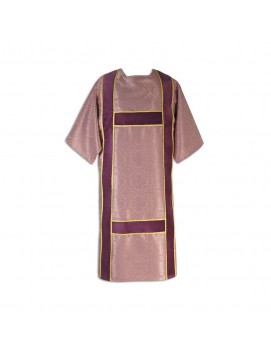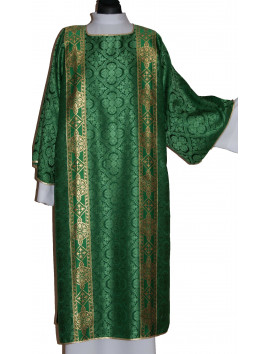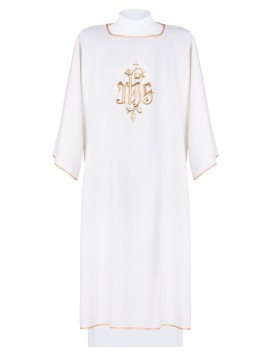The vestments worn by deacons in the Catholic Church are called the dalmatic and the stole. The dalmatic is a long, loose-fitting tunic worn over the alb, a white garment worn by all ministers at the altar. The dalmatic has wide sleeves and is often made of silk or other rich fabric. It is usually decorated with elaborate designs and often has a distinctive color that corresponds to the liturgical season or feast day. Deacons wear the dalmatic during Mass and other liturgical celebrations to signify their role as ordained ministers of the Church.
The stole is a long, narrow strip of cloth worn around the neck and draped over the front of the deacon's body. It is usually decorated with crosses or other religious symbols. The stole is a symbol of the deacon's authority to assist the priest during Mass and to proclaim the Gospel.

Can a Catholic deacon wear a cope?
While a Catholic deacon may wear a dalmatic, stole, and other liturgical vestments, the cope is not usually worn by deacons during the celebration of Mass or other liturgical functions. The cope is a large, cape-like garment worn by bishops, priests, and sometimes abbots or other high-ranking clergy. It is typically worn during processions, blessings, and other liturgical functions where the celebrant needs to move freely and with dignity while holding a monstrance or other liturgical object.
Deacons do not wear the cope during liturgical functions because it is not part of their traditional vestments. However, in some rare instances, a deacon may wear a cope when serving as a master of ceremonies or assisting a bishop or other senior cleric during a liturgical function. In such cases, the deacon would wear the cope at the discretion of the bishop or priest in charge of the liturgy.
Do deacons wear alb?
Yes, deacons in the Catholic Church wear an alb as part of their liturgical vestments. The alb is a long, white garment that covers the body from the neck to the ankles and is worn over street clothes. It is usually made of linen or cotton and is meant to symbolize the purity and simplicity of the Christian life. The alb is worn by all clergy, including deacons, during liturgical functions such as Mass, baptism, and other sacramental celebrations. However, unlike priests, deacons do not wear a chasuble over their alb during Mass. Instead, they wear a dalmatic, which is a long, loose-fitting tunic with wide sleeves, often decorated with elaborate designs. The dalmatic is a distinctive vestment that signifies the deacon's role as an ordained minister of the Church.
When can a deacon wear a dalmatic?
In the Catholic Church, deacons may wear a dalmatic during liturgical celebrations in which they have a special role. The dalmatic is a long, loose-fitting tunic with wide sleeves worn over the alb and stole. It is a distinctive vestment that signifies the deacon's role as an ordained minister of the Church and is often decorated with elaborate designs.
At Mass, deacons typically wear the dalmatic during the Liturgy of the Word and the distribution of Holy Communion. The dalmatic is also worn at other liturgical celebrations such as baptisms, weddings, and funerals.
It's worth noting that the use of the dalmatic may vary depending on the liturgical season or occasion. For example, during Advent and Lent, the dalmatic may be of a simpler design with less ornamentation.
Who can wear a dalmatic?
In the Catholic Church, the dalmatic is a liturgical vestment worn primarily by deacons during Mass and other liturgical celebrations in which they have a special role. The dalmatic is a long, wide-sleeved tunic worn over the alb and stole, usually made of silk or other fine materials. It is a distinctive vestment that signifies the deacon's role as an ordained minister of the Church.
In some exceptional cases, however, priests and bishops may also wear a dalmatic. For example, a bishop may wear a dalmatic during the celebration of Mass when he is not the principal celebrant, such as when he is presiding at a confirmation or ordination Mass. Similarly, a priest may be permitted to wear a dalmatic when he is presiding at a Mass with a deacon and there are no other dalmatics available.
Why does a deacon wear a dalmatic?
In the Catholic Church, the deacon wears a dalmatic as a liturgical vestment during Mass and other liturgical celebrations in which he has a special role. The dalmatic is a long, wide-sleeved tunic worn over the alb and stole. It is a distinctive vestment that signifies the deacon's role as an ordained minister of the Church and is often decorated with elaborate designs.
The dalmatic has its roots in ancient Roman dress and was adopted by the Church in the Middle Ages as the liturgical vestment for the deacon. The dalmatic is a symbol of the deacon's role as a servant of the Church and a sign of his ordination to the diaconate. It is also a reminder of the deacon's baptismal call to serve others and to participate in the mission of the Church.
What is the difference between dalmatic and chasuble?
The dalmatic and the chasuble are both liturgical vestments worn by clergy in the Catholic Church, but they serve different liturgical functions and have different designs.
The dalmatic is a long, wide-sleeved tunic worn over the alb and stole. It is worn primarily by deacons during Mass and other liturgical celebrations in which they have a special role. The dalmatic is a symbol of the deacon's role as a servant of the Church and a sign of his ordination to the diaconate. It is often decorated with elaborate designs and colors appropriate to the liturgical season.
The chasuble, on the other hand, is a sleeveless outer vestment worn by the priest during Mass. It is usually made of a heavy fabric and covers the priest's shoulders and arms, reaching down to the ankles. The chasuble is a symbol of the priest's role as the celebrant of Mass and represents the "yoke of Christ".




















